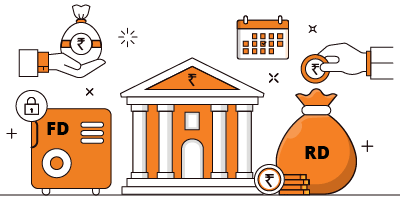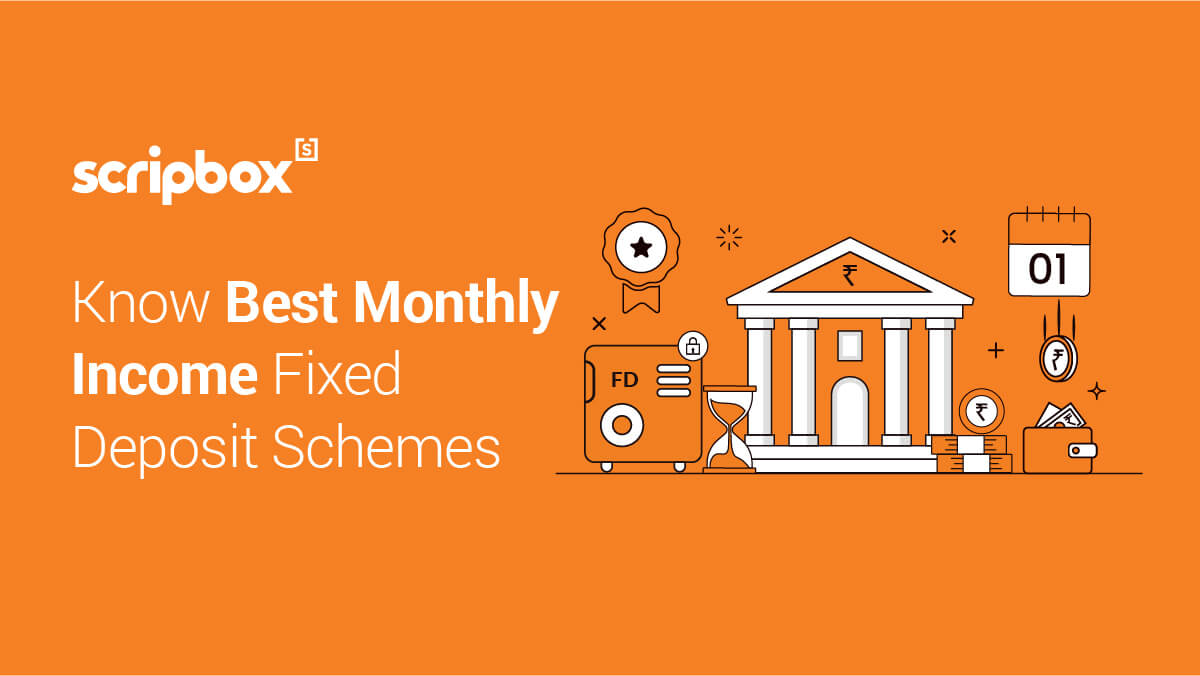Difference Between Fixed Deposit and Recurring Deposit
Both the fixed deposit and recurring deposit are investment options that encourage savings and guarantee returns in the form of interest. However, there are several differences between FD and RD. They differ in terms of investment, tenure, interest rates and interest payout frequency. In this article, we have covered fixed deposits and recurring deposits in detail, along with a comparison of FD vs RD.
What is a fixed deposit?
A fixed deposit is a traditional savings investment that offers fixed returns to investors. Investors can invest in a lump sum amount at the beginning of the FD tenure and have to stay invested until the investment tenure expires. The tenure of an FD varies between 7 days to 10 years. The minimum investment amount for fixed deposits FD is INR 100, and there is no limit on the maximum investment amount.
Fixed deposits offer guaranteed returns, and hence they are the most popular investment vehicles. Banks and financial institutions offer fixed deposits, and the FD rates they offer range between 3%-7%. Senior citizens are offered additional FD interest rates. The interest and maturity amount on FDs can be estimated using an FD calculator. Scripbox FD calculator is an online tool that helps investors determine the returns from their FD investment.
Investors can withdraw their FD investment plans prematurely. However, most banks and financial institutions charge a penalty for the same. And the rules for premature withdrawal vary for different banks. Alternatively, investors can take a loan against a fixed deposit account. This will help them meet their liquidity requirements while continuing their FD investment. Banks offer loans such as education loans and loan against property against a fixed deposit. Investors can use a loan EMI calculator to estimate their loan EMI. A Scripbox loan EMI calculator can be used as a personal loan EMI calculator, car loan EMI calculator and home loan EMI calculator.
Taxation
Investment in tax saving FD qualifies for tax exemption under Section 80C of the Income Tax Act, 1961. However, investment in all other FDs doesn’t qualify for a tax deduction. Investors can claim the tax benefits while filing their income tax returns. Interest income from FDs is taxable as per the individual investor’s income tax slab rates. Additionally, the interest income is also subject to TDS. If the PAN Card is furnished, the TDS rate is 10%, else it is 20%. Also, TDS is cut of the interest income exceeds INR 40,000 (INR 50,000 for senior citizens).
What is a recurring deposit?
Recurring deposits RD are one of the popular savings options that offer interest on deposits. A recurring deposit account allows individuals to save a small fixed amount regularly on a monthly basis. The RD account’s interest rate is predetermined, and upon maturity, one gets a lump sum amount. The RD account tenure ranges between six months to ten years.
The interest for these investment plans is compounded on a quarterly basis. The RD interest rates vary from bank to bank, as the rates are based on the tenure of the deposit and deposit amount. In India, the RD rates are in the range of 3.50% to 8.50%. Furthermore, senior citizen depositors are eligible for preferential interest rates. The senior citizen deposit rates are higher by 0.25% to 0.75%.
One can estimate their maturity amount and interest earned from an RD investment using Scripbox’s RD Calculator. The RD calculator is available online and is free to use. All that one has to do is input certain details such as deposit amount, tenure in months and interest rate. The calculator automatically determines the maturity amount at the end of the tenure and interest amount.
Investors cannot withdraw their RD investments prematurely. However, they can take a loan against their RD. Banks offer loans such as education loans and loan against property against a recurring deposit. Investors can use a loan EMI calculator to estimate their loan EMI. A Scripbox loan EMI calculator can be used as a personal loan EMI calculator, car loan EMI calculator and home loan EMI calculator.
Explore Best Banks in India
Benefits of Investing in FD Vs RD?
| Benefits | Fixed Deposit | Recurring Deposit |
| Encourage Savings | FDs encourage investors to save a lump sum amount for a fixed tenure. | RDs encourage small savings. Moreover, they inculcate financial discipline through regular investing of a fixed amount. |
| Tax Benefits | Investment in tax-saving FD qualifies for tax exemption under Section 80C of the Income Tax Act, 1961. | Investment in Post Office RDs qualifies for tax exemption under Section 80C of the Income Tax Act, 1961. |
| Safe investment | Investment in FDs is safe, and it guarantees returns in the form of interest. | Investment in RDs is safe, and it guarantees returns in the form of interest. |
| High-interest rate | FD rates are higher than savings account interest rates. Interest earned from FD can be calculated using a fixed deposit calculator. | RD interest rates are higher than a bank savings account. Interest earned on RD can be calculated using a recurring deposit calculator. |
| Liquidity | FDs are liquid investments. Though they have a fixed tenure, investors can withdraw the investments anytime with a penalty. | Investors can take a loan against RD investments, hence making them liquid investments. |
| Flexibility | FDs have a tenure ranging from 7 days to 10 years. Investors can choose any tenure as per their goals. | RD investment tenure ranges between 6 months to 10 years. Investors are free to choose the tenure of the RD based on their investment goals. |
You may also like to read about the RD vs FD vs SIP
Compare FD vs RD
Following are the differences between fixed deposits and recurring deposits (FD vs RD)
| Particulars | Fixed Deposit (FD) | Recurring Deposit (RD) |
| Frequency of Deposit | One time | Monthly |
| Tenure | 7 days to 10 years | 6 months to 10 years |
| Minimum Deposit Amount | INR 100 | INR 10 |
| Interest Rates | FD interest rate ranges between 3% to 7% | RD interest rates range between 3.50% to 8.50% |
| Payout frequency | FDs allow monthly or quarterly or yearly payouts. Hence are a good source of regular income. | Returns from RD are realised only upon maturity of the scheme. Investors are entitled to a lumpsum amount at the end of the investment tenure. |
| Premature withdrawals/closure | Not available. However, depositors can choose to discount the investment and withdraw the amount. Although, the interest in such cases is lower. | Not available. However, depositors can choose to discount the investment and withdraw the amount. Although, the interest in such cases is lower. |
| Auto-Renewal | Available | Not available |
| Default | Investors cannot default as one lump sum payment is done at the beginning of the tenure. | If the depositors fail to make RD payments for six consecutive months, the bank has the right to close the account. |
| Tax Deducted at Source (TDS) | 10% on interest income exceeding INR 40,000, INR 50,000 for senior citizen depositors20% if PAN is not submitted | 10% on interest income exceeding INR 40,000, INR 50,000 for senior citizen depositors20% if PAN is not submitted |
| Tax Saving | Available for deposits with 5 year lock-in period | Not available |
| Deposit Insurance | Covered | Covered |
| Investment Habit | FDs are onetime investment options that do not create a habit of regular investment among the depositors. | RDs are regular investment options that require investors to invest monthly for the scheme’s entire duration. Therefore, creating an investment habit among the depositors. |
How should you choose between an FD and RD?
The choice between FD vs RD is very subjective. Both the schemes offer fixed interest throughout the tenure of the deposit. Also, both schemes are safe and secured investment options.
A fixed deposit investment is suitable for individuals wishing to invest a lump sum amount. Also, they are a good investment option for investors looking for regular cash inflow. FDs offer monthly or quarterly payouts. For example, retired individuals can invest their retirement benefits in the long term FD. The scheme offers capital protection and also regular interest to meet monthly expenses. While salaried individuals can invest their year-end bonus and use the money to buy a car or bike or renovate their house, etc.
On the other hand, a recurring deposit scheme doesn’t require one to invest a lump sum amount. One can invest small amounts on a monthly basis and accumulate a large amount at the end of the investment tenure. Therefore, RDs are suitable for investors who wish to set aside small amounts every month. For example, one can invest in a recurring deposit scheme to match a child’s school fees at the beginning of the academic year. Also, one can start saving small amounts for their dream international holiday.
Therefore, while choosing between FD vs RD, one should consider their availability of funds. In case a lump sum amount is available with an individual, then FDs may be the right investment option. For depositors who do not have a lump sum amount, but wish to invest small amounts in a safe and secured scheme, RDs will be a good option.
You may also like to read about the SIP vs RD















Show comments